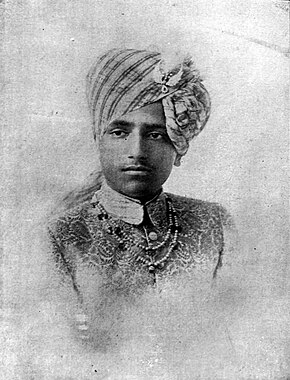| Yeshwantrao Ghorpade | |||||
|---|---|---|---|---|---|
| Raja of Sandur | |||||
 | |||||
| Reign | 5 May 1928 - 1 April 1949 | ||||
| Coronation | 20 June 1928 | ||||
| Predecessor | Venkata Rao III | ||||
| Successor | Murarirao | ||||
| Born | (1908-11-13)13 November 1908 Sanduru | ||||
| Died | 11 October 1996(1996-10-11) (aged 87) Sanduru | ||||
| |||||
| House | Ghorpade Dynasty | ||||
| Religion | Hinduism | ||||
Maharaja Srimant Yeshwantrao Hindurao Ghorpade (13 November 1908 - 11 October 1996) was the ruler of the princely state of Sandur from 1928 to 1949. He was the last Rajah of Sandur and presided over the accession of the state to the Dominion of India. He was also an ardent wildlife conservationist and member of the Bombay Natural History Society.
Early life and education
Yeshwantrao was born on 13 November 1908 in Sanduru, the capital of Sandur state to Bhujangrao Yeshwantrao Raje Ghorpade, the jagirdar of Gajendragad and his wife, Tarabai Sahib Ghorpade. Yeshwantrao had his education at Baldwin High School, Bangalore and Holkar College, Indore and graduated from the Allahabad University. On 5 May 1928, he succeeded his deceased cousin, Venkata Rao III as the Raja of Sandur and was formally installed on 20 June 1928.
Reign
Yeshwantrao ruled as the Rajah of Sandur till the state's accession to India on 10 August 1947. The state was initially governed by an administrator till 5 February 1930 when he assumed full administrative powers. Yeshwantrao's reign is notable for his social and administrative reforms apart from his efforts at wildlife conservation. Yeshwantrao abolished untouchability and opened the gates of Hindu temples to all castes through legislation in 1932. In 1931, he set up a legislature comprising an upper and a lower house, the Sandur State Council.
The famous writer and wildlife conservationist, Madhavaiah Krishnan was an employee of the Sandur State Civil Service and was instrumental in drawing the Rajah's attention to wildlife conservation. After independence, Ghorpade served as Vice-President of the Expert Committee of Wildlife Conservation in India.
Honours
Yeshwantrao was a recipient of the King George V Silver Jubilee medal (1935), King George VI coronation medal (1937) and the Indian Independence Medal (1948).
References
| Yeshwantrao Ghorpade Ghorpade DynastyBorn: 13 November 1908 | ||
| Regnal titles | ||
|---|---|---|
| Preceded byVenkata Rao III | Raja of Sandur 1928–1949 |
Succeeded byMonarchy abolished |
| Political offices | ||
| Titles in pretence | ||
| Preceded byNone | — TITULAR — Raja of Sandur 1949–1996 Reason for succession failure: Monarchy abolished |
Succeeded byM. Y. Ghorpade |